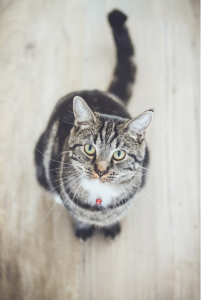Most people do not think about training a cat the same way they think about training a dog to listen to commands. Cat’s routinely do their own thing. They are the boss and we, their loyal subjects.
It’s time to revisit our views on training cats. Studies are showing that daily training can reduce stress and subsequently illness in our feline friends. Stress often leads to behavioral problems such as aggression and inappropriate litter box use. It also contributes to illnesses such as obesity, upper respiratory infections, and lower urinary tract disease. By using positive reinforcement, such as clicker training, cats can learn many tricks including sit, spin, touch, and high five!
How do you clicker train your cat?
1. Assemble the Right Tools
- You will need a great reward. This could be kibble, a special soft treat, a toy, or even a good brushing. What motivates your cat and what will they work for?
- Determine your event marker. An event marker is something used to convey to your pet they have performed a desired behavior. In clicker training the marker is a “click” sound made by a handheld clicker. When your pet performs the desired behavior, a “click” (meaning yes or good job) is sounded, followed by a reward.
2. Make Each Click Count
- Priming the clicker- the first step in clicker training is to pair the treat with a click to form a positive association with the sound. This is actually very easy to do. Immediately after clicking, give your cat a treat. Wait until he has eaten it then click again and treat again. Priming the clicker can take anywhere from 5-20 repetitions before the association is made. Now you have a clear way of communicating with your cat.
3. Click after Desired Behaviors
- A simple click, followed by a reward, will communicate to your cat they have performed an appropriate behavior. For example, in teaching your cat to sit, click and follow with a treat every time your pet sits on their own after you say “sit”. They will soon learn the act of sitting after you say “sit” gets them a treat.
- Click only when your cat performs the desired task.
- Timing is essential. Click and treat at the exact time they perform the desired task.
- What your cat can learn is only limited by your imagination.
You’ve got it, right?! Trust me, try it. Clicker training is easier than it seems and is a fun, rewarding, and wonderful bonding experience for you and your pet. There are numerous sources available including Dr. Sophia Yin at drsophiayin.com and Karen Pryor at karenpryoracademy.com. Good luck and share your experiences on our social media!

Written By: Tara Corridori, LVT
Edited By: Dr. Corrina Snook Parsons VMD
Information Obtained By: catster.com
